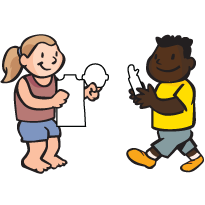Boston Children's Museum
308 Congress Street, Boston, MA 02210
617-426-6500
© Boston Children’s Museum 2025
Website Design by JackrabbitCommunities from all over the world use folktales to convey cultural beliefs and practices. In parts of Liberia, elders tell folktales to children in the palaver hut, a place the community also uses for conflict resolution.
Print out the story “Head, Body, Legs.” Print out and cut a paper body part for each student from the templates (some students may have to share, or some may have multiple parts so that the numbers are even). Cut enough so that the body parts add up to a number of total bodies.

Ask children to sit in a circle, then ask them if they have ever read or listened to stories or fairy tales with their families. What kinds of stories have they read? Where do they read the stories? Explain that in the country of Liberia, people in some communities share stories with each other in a place called the palaver hut, and they sit in a circle while they share the stories. Often, the stories have an important message about how people in a community should behave.
Listen to this Liberian folk tale, and try to put together your OWN head, body, and legs!
After they have created their “bodies”, bring your students together away from the materials to talk about what they have discovered. Was that easy to do or was it difficult? What could they try to make it easier? What could they try to make the game more challenging? Brainstorm a list of new game rules (or suggest some of your own) that might make the game harder or easier.
Mix up the body parts again, and challenge your students to then create whole bodies using some of the new rules that they have suggested. You can also suggest some of your own, such as:
After trying some of these new rules, bring your students back to a seated position in the circle/palaver hut. Ask them to “tell the story” of their experience working together today. What went well? What could have gone better? What other ways could they have worked together to create the bodies? If they were telling the story of their day together, what would be the lesson?